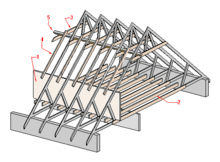Loft conversion
A loft conversion or an attic conversion is the process of transforming an empty attic space or loft into a functional room, typically used as a bedroom, office space, a gym, or storage space. Loft conversions are one of the most popular forms of home improvement in the United Kingdom as a result of their numerous perceived benefits. The installation of a loft conversion is a complicated process, and whilst it may be possible to attempt a 'DIY' loft conversion, the large amount of work involved often results in many people choosing to contract a specialist loft conversion company to undertake the task.



Another type of loft conversion is converting non-residential spaces (most commonly warehouses, docks, former factories or water towers) into habitable homes. This form of loft conversion has its origins in the USA. This form of loft first became popular in the SoHo section of New York City during the 1960s. Artists created living spaces on the upper levels of obsolete industrial buildings, sometimes located in the heart of the city. In the pioneering period of lofts, most SoHo buildings were not zoned as residential and the lofts were being used illegally as living space. In 1971, New York City legalised the residential use of space in SoHo, and loft living became popular throughout the neighbourhood.[1] Loft living spread to other previously industrial Manhattan neighbourhoods including TriBeCa, Chelsea and Greenwich Village.
Feasibility
The first stage of any loft conversion is a close inspection of the loft space to find out its exact dimensions and whether conversion is feasible. On entering the loft one needs to establish if there is adequate room under the ridge of the roof. A measurement of 2.3 metres is required to allow enough headroom, although you may find that you can still get a useful room from as little as 7 feet (2.1 metres), and there must be at least 2 metres clearance above the position of the access stairs.
Due to the slope of the roof and the required access headroom, the feasibility of a loft conversion is dependent upon a minimum height of approximately 2.2 m (7 ft 6 in) measured from the joist to the apex. Providing that this requirement is met, most properties will likely possess the potential to have the loft space converted.
Types
There are several types of loft conversion with two main types being the most common:
Roof window conversion
Roof windows are often an attractive option for homeowners due to their ability to fit into the line of the roof; thus not necessitating any restructuring of the roof itself. The installation of such windows will provide the loft space with substantial light. In the UK, a roof window conversion can often be completed under permitted development rights and will not require planning permission, although they will always require building regulation approval.
Dormer conversion
A dormer is a window-featured extension of the roof, usually installed to provide more space and headroom within the loft, in addition to improved staircase access. Dormers are also popular due to the aesthetic enhancement to a property that they provide. In the UK, the installation of a dormer is subject to planning permission requirements from the local authorities only when certain rules aren't met. Most dormer conversions come under permitted development.
Regulations
Building control regulations
Building control regulations will almost always be required if the loft space is being converted into any usable form of accommodation, subject to the local authority requirements. Planning permission may not be required as many conversions fall within the permitted development rights. In some areas of the United Kingdom, known generally as 'designated areas', permitted development rights are more restricted. For example, a Conservation Area, a National Park, an Area of Outstanding Natural Beauty, a World Heritage Site or the Norfolk or Suffolk Broads. These above will generally have restricted permitted development rights. The local planning authority may have removed some of the permitted development rights with an Article 4 direction, in these cases a planning application will be required. These requirements are in place to ensure that the necessary construction criteria are met and that all health and safety laws, amongst other things, have been satisfied. A professional loft conversion specialist will usually conduct all liaisons with the relevant local authority.[2]
Properties which have had change of use from commercial use into homes may not then be able to develop the property further under household permitted development legislation. [3]
Structural strengthening
The existing ceiling joists in most houses are only designed to support the weight of a ceiling, therefore additional support will be required to transfer the loads from the new loft floor to the walls of the house, since the alignment of roof supports would generally need to be altered, causing a significant increase in pressure at specific points on the flooring of the property. The most common method used is to install I-beams or rolled steel joists (RSJs), these can either be installed in single lengths or in smaller sections which are bolted together. New timber joists are then installed between the RSJs onto which the new floor can be laid. A structural engineer will calculate the size of the RSJs and joists.
Benefits
Loft conversions yield numerous benefits for homeowners, which may be the reason for their increasing popularity. Often, up to 30% of a property’s potential space is located within the loft area. Converting the attic will therefore provide a significant amount of room that may be used for a wide variety of accommodation; often a bedroom, bathroom, office, or entertainment room.
In 2016 it was reported that a loft conversion could increase the value of a home by 20% in the UK by Robert Gardner, Chief Economist at Nationwide.[4]
Many families also choose to convert their loft area as a means of obtaining more space without having to endure the costly and stressful process of moving property.
Key features of former industrial space that makes for attractive use as a loft include high, unfinished ceilings, large windows, exposed brick or cinder block walls and exposed duct work. Many industrial lofts have only partial height walls separating rooms or areas within the space. Some lofts even preserve the industrial-era freight elevators that open into the living space.
References
- Zukin, Sharon, Culture and Capital in Urban Change, ISBN 0-8135-1389-8
- Planning Portal (Department for Communities and Local Government) (2012). "Planning Permission for Loft Conversion". Retrieved 2012-05-05.
- Garrett, James. "Planning Permission". www.planningportal.co.uk. Retrieved 2019-05-27.
- Association, Press (2016-03-27). "Home extension or loft conversion 'can add 20% to house value'" (PDF). The Nationwide. ISSN 0261-3077. Retrieved 2019-05-27.